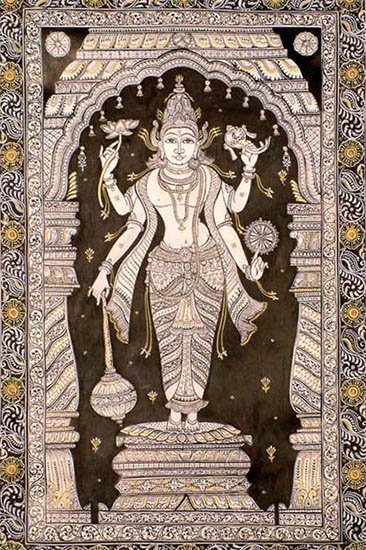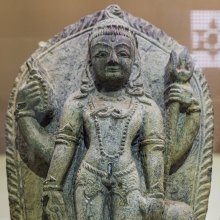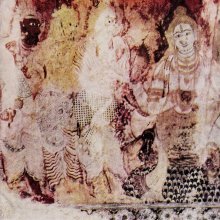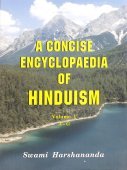Lakulisha, Lakulīśa, Lakuli-isha: 9 definitions
Introduction:
Lakulisha means something in Buddhism, Pali, Hinduism, Sanskrit. If you want to know the exact meaning, history, etymology or English translation of this term then check out the descriptions on this page. Add your comment or reference to a book if you want to contribute to this summary article.
The Sanskrit term Lakulīśa can be transliterated into English as Lakulisa or Lakulisha, using the IAST transliteration scheme (?).
Images (photo gallery)
In Hinduism
Shaivism (Shaiva philosophy)
Source: Wisdom Library: ŚaivismLakulīśa (लकुलीश), one of the fifty Rudras according to the Caryāpāda section of the Makuṭāgama (one of the 28 Saiva Siddhanta Agamas).
Source: academia.edu: Śivadharmottara Purāṇa: a SurveyLakulīśa (लकुलीश), the founder of the Pāśupata sect, is commonly held to originate from Gujarat, his image being widely diffused especially in Gujarat, Bengal and Orissa. His usual iconic representation, however, features a club, in conformity to the etymon of his name (“the Lord with the club”; lakula, or lakuṭa, or laguḍa).
Source: Archaeological Survey of India: Śaiva monuments at Paṭṭadakal (śaivism)Lakulīśa (लकुलीश).—Śiva, taking the four Vedas in the form of a stick and holding it in his hand, came to the earth to impart the principles of Śaivism. According to Skāndapurāṇa, he descended at Kāyāvarohaṇa (Prabhāsa-khaṇḍa, adhyāya 17). As he holds a stick (laguḍa or lakula in Sanskrit), he has the name Laguḍīśa, Lakulīśa or sometimes even Nakulīśa. Śaivism that he taught is known as Nakulīśa-Pāśupata.
By and large, Lakulīśa is shown naked, carrying a stick in one of his hands. He preached the principles of yoga and the importance of observing celibacy. According to him, with yogic power one can control one’s desires. That is the reason why he is ūrdhvaretas because it symbolizes the control over oneself.
Source: academia.edu: KāpālikasLakulīśa (लकुलीश) is the name of Śiva he assumes in this Kali age.—According to a copper-plate inscription found in Malhar, Chhattisgarh, written around 650 CE: “Now having reached the kali age, Śiva descended in this world as Lord Lakulīśa. He was born in the family of a Brahman called Somaśarman (“Whose Shelter Is the Moon”), was initiated by him into the mahāvrata, and became Jagadindu (“Moon of the World”). He then initiated Musalisa. Then, in due course, the venerable Bhīmasoma, disciple of Tejasoma and grand-disciple of Rudrasoma, [was also initiated] according to the tradition started by Soma”.

Shaiva (शैव, śaiva) or Shaivism (śaivism) represents a tradition of Hinduism worshiping Shiva as the supreme being. Closely related to Shaktism, Shaiva literature includes a range of scriptures, including Tantras, while the root of this tradition may be traced back to the ancient Vedas.
Shilpashastra (iconography)
Source: Archaeological Survey of India: Śaiva monuments at Paṭṭadakal (śilpa)Lakulīśa (लकुलीश) is a sculpture found at the temple of Vijayeśvara, at the southern side, eastern niche.—Śiva in the form of Lakulīśa is in standing pose holding a laguḍa, “a stick” in his right hand. He is naked and surprisingly his headwear is like that of a Pāśupata saint. He wears usual ornaments, but they are not well polished. So it is not easy to identify and describe them.
Lakulīśa (लकुलीश) is also found as a sculpture on the exterior (southern wall) of the temple of Trailokyeśvara.—Like in the temple of Lokeśvara here is also an image of Lakulīśa, naked, ūrdhvaretas and with a stick in his right hand. This image is almost identical with one in the Lokeśvara. Here the face of the statue is weather-beaten.
Above the niche of Lakulīśa there are two pairs of flying figures of demigods. Their body swing gives really the impression of flying. The knees of both couples are flexed in such a way that legs of the pair on the left looks as if they are touching the ground and the couple on the right is flying away. One of the legs of the female figure of the couple on the left side is hidden behind the legs of the male figure whereas we notice all four legs of the couple in the right. The position of their legs and feet show the lightness of figures. They are carrying offerings to god.

Shilpashastra (शिल्पशास्त्र, śilpaśāstra) represents the ancient Indian science (shastra) of creative arts (shilpa) such as sculpture, iconography and painting. Closely related to Vastushastra (architecture), they often share the same literature.
Shaktism (Shakta philosophy)
Source: Google Books: ManthanabhairavatantramLakulīśa (लकुलीश) refers to one of the eight Bhairavas (bhairava-aṣṭaka) associated with Nādapīṭha (identified with Kulūta), according to the Manthānabhairavatantra, a vast sprawling work that belongs to a corpus of Tantric texts concerned with the worship of the goddess Kubjikā.—[...] The eight Bhairavas (bhairavāṣṭaka): Amogha, Mahānāda, Aṅkura, Śivottama, Ekarudra, Lakulīśa, Sūkṣmīśa, Ekanetra.—(Note the variant Kulākula)

Shakta (शाक्त, śākta) or Shaktism (śāktism) represents a tradition of Hinduism where the Goddess (Devi) is revered and worshipped. Shakta literature includes a range of scriptures, including various Agamas and Tantras, although its roots may be traced back to the Vedas.
Purana and Itihasa (epic history)
Source: archive.org: Shiva Purana - English TranslationLakulīśa (लकुलीश) is the name of a Gaṇanāyaka (“leader of Gaṇas”), according to the Śivapurāṇa 2.3.40 (“The Marriage Procession of Śiva”).—Accordingly, as Brahmā narrated to Nārada: “[...] O Nārada, Yajvākṣa, Śatamanyu and Meghamanyu each of these leaders too went with so many crores. Kāṣṭhāgūḍha, the leader of Gaṇas, went with sixtyfour crores. So too Virūpākṣa, Sukeśa, Vṛṣabha and Sanātana. Similarly Tālaketu, Ṣaḍāsya, the eternal Cañcvāsya Saṃvartaka, Caitra and the lord Lakulīśa himself. [...]”.

The Purana (पुराण, purāṇas) refers to Sanskrit literature preserving ancient India’s vast cultural history, including historical legends, religious ceremonies, various arts and sciences. The eighteen mahapuranas total over 400,000 shlokas (metrical couplets) and date to at least several centuries BCE.
In Buddhism
General definition (in Buddhism)
Source: Google Books: The Buddhist Caves at AurangabadLakulīśa is described as an incarnation of Śiva in the Purāṇas. Lakulīśa seems to refer to the club always held by this figure, and as related in the Viśvakarmāvatāra Vāstuśāstra, Lakulīśa should always be represented in dhyānāsana, with an erect penis and holding a citron in his right hand and a club in his left. The town of Karvan in Gujarat is referred to as the birthplace of Lakulīśa, and the Pāśupata cult became especially strong in Lata, th eregion between the mouth of the Tapi and Narmada rivers which historically had very close ties to the Ajatna range. Kauṇḍinya’s commentary to the Pāśupatasūtra states that Lakulīśa went to Ujjain where he initiated his first pupil Kuśika.
Languages of India and abroad
Kannada-English dictionary
Source: Alar: Kannada-English corpusLakulīśa (ಲಕುಲೀಶ):—
1) [noun] name of the founder (2nd century a.d.) of the Śaiva Pāśupata sect.
2) [noun] the sect itself.
--- OR ---
Lakuḷīśa (ಲಕುಳೀಶ):—[noun] = ಲಕುಲೀಶ [lakulisha].
Kannada is a Dravidian language (as opposed to the Indo-European language family) mainly spoken in the southwestern region of India.
See also (Relevant definitions)
Partial matches: Isha, Lakuli.
Starts with: Lakulishanatha, Lakulishapashupata.
Full-text (+30): Musalisa, Somasharman, Kayavatara, Lakula, Jagadindu, Kalamukha, Dharmagale, Lakulishapashupata, Lakulagama, Ilakulam, Aghoramurti, Avatara, Lakuleshvara-agama, Lakulishanatha, Sukshmisha, Siddhanta, Agama, Kayavarohana, Shivottama, Ekarudra.
Relevant text
Search found 13 books and stories containing Lakulisha, Lakulī-īśa, Lakuli-īśa, Lakuli-isa, Lakuli-isha, Lakulīśa, Lakulisa, Lakuḷīśa; (plurals include: Lakulishas, īśas, isas, ishas, Lakulīśas, Lakulisas, Lakuḷīśas). You can also click to the full overview containing English textual excerpts. Below are direct links for the most relevant articles:
Lakulisha-Pashupata (Philosophy and Practice) (by Geetika Kaw Kher)
The Lakulisa-Pasupata activity in Orissa < [Chapter 2 - Spread and Transition]
Rise of Tantric Elements in Lakulisa-Pasupata order < [Chapter 2 - Spread and Transition]
The Skanda Purana (by G. V. Tagare)
Chapter 76 - Importance of the Pair of Lakulīśa Liṅgas < [Section 1 - Prabhāsa-kṣetra-māhātmya]
Chapter 177 - Greatness of Lakulīśa < [Section 1 - Prabhāsa-kṣetra-māhātmya]
Chapter 79 - Greatness of Lakulīśvara (Lakuli-īśvara) < [Section 1 - Prabhāsa-kṣetra-māhātmya]
Stupas in Orissa (Study) (by Meenakshi Chauley)
The Religion and Philosophy of Tevaram (Thevaram) (by M. A. Dorai Rangaswamy)
The various sects of Shaivism < [Volume 2 - Nampi Arurar and Mythology]
Chapter 81 - Thirunagaikaronam or Tirunakaikkaronam (Hymn 46) < [Volume 3.6 - Pilgrim’s progress: away from Otriyur and Cankili]
Chapter 3 - The final goal < [Volume 4.2.3 - Philosophy of God]
The Siva Linga: Conceptual, Iconographical and < [January – March, 1996]
The Lingayats-Their Religion and Literature < [May 1937]
Reviews < [Jul–Sept 1971]
Shaiva Upanishads (A Critical Study) (by Arpita Chakraborty)
6. Theistic Philosophy < [Chapter 1 - Introduction]
Related products


